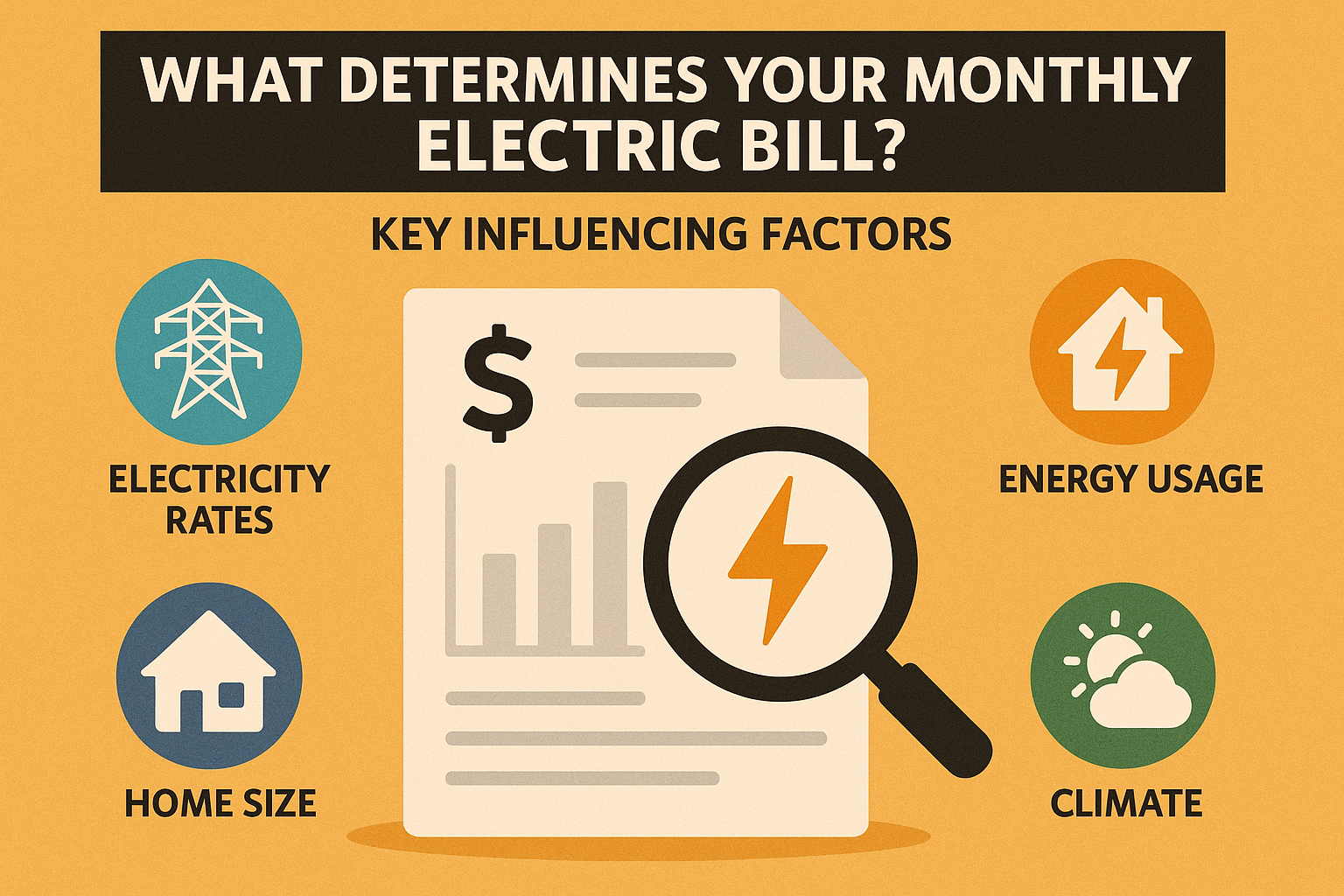What Determines Your Monthly Electric Bill? Key Influencing Factors

Introduction
With the consistent rise in energy demands and an ever-changing landscape of utility rates, homeowners and renters alike are becoming more invested in understanding and actively managing their household electricity expenses. Knowing what determines your monthly electric bill is crucial—it not only empowers you to make cost-effective decisions in your everyday life but also encourages simpler, more energy-conscious habits that benefit both your wallet and the environment. A thorough comprehension of billing factors reveals where your money goes each month and where you can save without sacrificing comfort.
By studying the elements that shape your bill, you can gain insight into how your home measures up to the average electricity bill. Benchmarking your usage against regional or national averages can help you spot inefficiencies or unexpected spikes in energy consumption. Armed with this knowledge, you’ll be able to develop a more targeted, practical approach to reducing your electric bill and optimizing your home’s overall efficiency.
Energy Consumption Habits
The routines and choices you make each day have a profound influence on your energy consumption. Households that use energy-intensive appliances, such as central air conditioners, electric furnaces, or water heaters, during high-demand hours will inevitably incur higher charges. Small appliances and gadgets, though individually low-consumption, can collectively add a significant amount to your bill if left running needlessly or plugged in round-the-clock. Understanding which devices are “energy hogs” in your home gives you the opportunity to modify your behavior and reduce unnecessary waste. For example, using heavy appliances during off-peak hours, relying on energy-saving features like programmable thermostats or occupancy sensors, and cultivating habits such as turning off switches when leaving a room can all help drive substantial reductions in your bill over time.
Importance of Regular Maintenance
Collaborating with your energy-saving habits, regular maintenance of household systems and appliances enhances efficiency and longevity. Filters, vents, and ducts that are clogged or dirty strain HVAC units, resulting in higher energy consumption and an increased risk of costly repairs. Tight door seals on refrigerators, clean coils, and well-maintained laundry machines can prevent wasted energy. Routine checks and timely servicing extend appliance life and help you spot inefficiencies before they inflate your monthly costs.
Home Size and Insulation
The physical dimensions and layout of your living space play a pivotal role in your overall electricity demand. Larger homes, especially those with open layouts or multiple floors, typically require more energy to maintain desired temperatures, particularly in regions with extreme climates or households with numerous occupants. However, it’s not just size that matters—insulation quality and air sealing determine how efficiently your home retains heat in the winter and cool air in the summer. Poorly insulated walls, attics, or basements allow air leaks and rapid temperature changes, leading your heating and cooling units to work harder and longer, and, as a result, consuming more power.
Maximizing Energy Efficiency
Enhancing your home’s insulation and sealing air leaks are proactive steps with a lasting impact. By installing additional insulation in key areas, weatherstripping around doors and windows, and using thermal window coverings or storm doors, you maintain a stable indoor air environment and reduce the demand on your HVAC systems. These improvements can be relatively affordable and may even qualify for rebates from your utility provider or local government. Over time, the energy savings from such upgrades add up, especially in climates with pronounced seasonal shifts. Ultimately, the better your home “holds” its temperature, the lower your monthly energy spend will be.
Seasonal Variations
Power usage patterns fluctuate with the seasons, often resulting in noticeable changes in your monthly electric bill. During the hottest parts of summer and the coldest stretches of winter, heating and cooling systems typically account for a significant portion of your total energy consumption. Air conditioners may need to run almost continuously to combat summer heat, while in winter, electric furnaces or space heaters become essential household items in many regions. In contrast, the temperate months of spring and fall typically result in lower energy use, as reliance on climate control systems decreases and natural ventilation can be utilized.
Adapting to Seasons
Being deliberate with your habits can help you soften seasonal spikes. In summer, running ceiling fans in conjunction with air conditioning allows you to set the thermostat a few degrees higher without sacrificing comfort, reducing overall cooling costs. In winter, layering warm clothes, using thick blankets, and sealing drafts can help keep you cozy while lowering your thermostat setting and reducing heating demand. Installing and programming a smart thermostat to adjust settings automatically while you sleep or are away from home further optimizes climate control and extends savings throughout the year.
Utility Rate Structures
The pricing system established by your utility provider directly affects every kilowatt-hour you use. Many providers implement time-of-use (TOU) or tiered pricing plans, which means that electricity rates vary depending on when electricity is consumed. During periods of high demand—also known as “peak hours”—you may pay premium rates, while off-peak times (such as late at night or early morning) offer lower prices. This presents an opportunity for households willing to shift laundry, dishwashing, or vehicle charging to off-peak times to reduce their monthly costs significantly. To make informed decisions about when and how to use specific appliances, you can refer to resources like the U.S. Department of Energy, which helps consumers understand the typical energy consumption of their devices. Some providers even introduce special incentive programs, rebates, or discounts for customers who demonstrate flexible or reduced usage during peak events.
Understanding Your Bill
Deciphering your monthly utility bill is crucial to managing costs effectively. Each bill typically includes details about your usage, rate plan, demand charges, and potential fees or credits. Analyzing these entries provides insight into your consumption patterns and highlights areas where adjustments could yield savings. Signing up for tools or notifications from your provider, or exploring programs and rebates (such as those offered for purchasing efficient appliances or enrolling in demand response programs), can further stretch your budget and help you stay ahead of any upcoming rate changes.
External Factors
While household usage has the most direct impact on your electric bill, specific external influences can unexpectedly alter your monthly costs. Electricity prices are partly determined by the changing costs of fuels used in power plants, such as natural gas or coal, and these costs can spike due to supply chain disruptions, geopolitical events, or inflationary pressures. Local investments in grid updates, renewable energy sources, and transmission improvements might also be passed on to consumers in the form of higher rates or special surcharges. Moreover, shifts in government policy, new environmental regulations, or technological upgrades required of utilities can result in additional cost adjustments on your monthly statement.
Looking Ahead
Staying informed about local, regional, and national trends can help you anticipate and plan for external changes that may impact your electric bill. Following your utility provider’s updates or monitoring government policy announcements about rate shifts or renewable integration allows you to stay several steps ahead. Many utilities offer educational resources, pilots, or programs, and support for energy efficiency. Make the most of these resources to help stabilize and predict your energy budget going forward.
Conclusion
Achieving mastery over your household energy costs begins with a clear understanding of what truly drives your monthly electric bill. By taking a proactive approach to adjusting your daily habits, investing in basic home improvements, staying up-to-date with your electric rate plan, and selecting efficient appliances, you can significantly reduce your bill and unlock lasting savings. Comparing your progress against trusted benchmarks, such as the average electricity bill, gives you a concrete roadmap to higher efficiency and measurable results.




